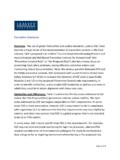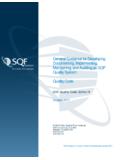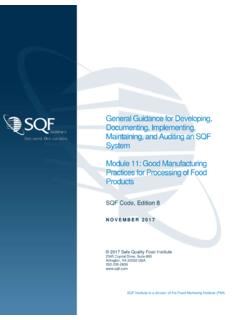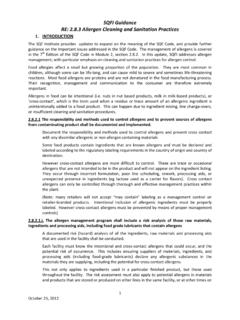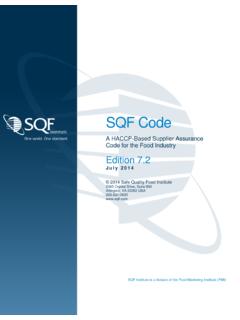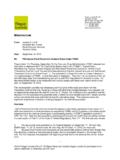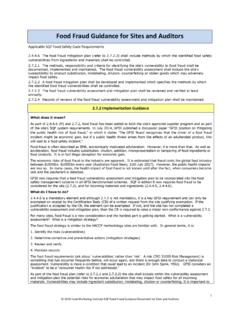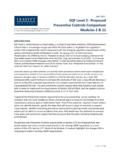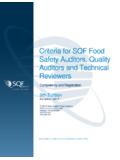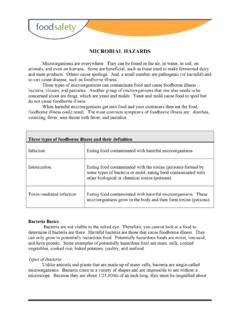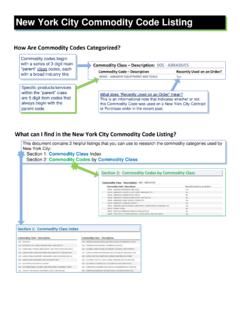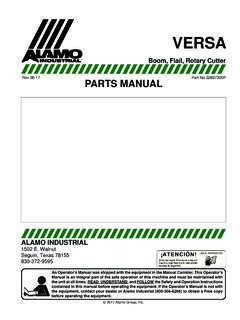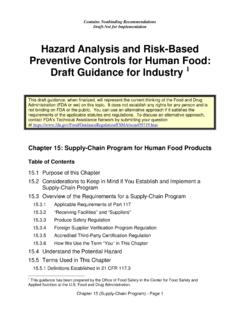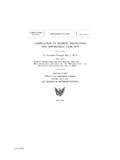Transcription of Introduction - SQF I
1 Guidance for the Implementation of the Preventive Controls for Human Food Rule for SQF Certified Sites Introduction A documented and implemented SQF System goes a long way in preparing certified sites for enforcement, the FDA Preventive Control Rule for Human Food (or Rule) has specific requirements that may go beyond what is required by the SQF Code or are otherwise different. This document identifies and describes these requirements organized by where they are likely to correspond to the requirements in the SQF Code. While comprehensive, this document does not replace a thorough review of the Rule to assure proper compliance. General Hazard Analysis. Radiological hazards: The SQF Code requires that a food safety plan is to be prepared according to CODEX- or NACMCF-based HACCP guidelines which stipulate that biological, chemical and physical hazards are to be identified as part of the hazard analysis.
2 The Rule further identifies radiological hazards as a chemical hazard that must be assessed as part of the hazard analysis. Holding and distribution of human food by products for use as animal food. Food by products for use as animal food: The SQF Code does not specifically address the safety of held and transported food by-products for use as animal food. Carefully read the requirements of this section of the Rule if your site holds and distributes by-products of food products produced at your site to another site for use as animal food. Subpart D Modified Requirements Attestations for qualified facilities; sites that store unexposed packaged food: This section contains a specific requirement of the Rule for qualified facilities that is not addressed by the SQF Code.
3 Carefully read this section of the Rule to determine the attestations that must be submitted to FDA if you are a qualified facility, as per the Rule. Additionally, this section of the Rule applies to those sites solely engaged in the storage of unexposed packaged food, such as a warehouse or distribution center; again, carefully review the section to assure compliance. Subpart E Withdrawal of a Qualified Facility Exemption Withdrawal of a qualified facility exemption: This section of the Rule addresses specific requirement including circumstances that may lead FDA to withdraw a qualified facility exemption under (a) including: issuance of an order to withdraw a qualified facility exemption; compliance with, or appeal of, an order to withdraw a qualified facility exemption; timeframe for issuing a decision on an appeal; and reinstatement of a qualified facility exemption that was withdrawn.
4 Carefully review this section to assure compliance. Page 1 of 13. 2016 Food Marketing Institute. All rights reserved. Guidance for the Implementation of the Preventive Controls for Human Food Rule for SQF Certified Sites Key Terms Many of the terms used in the Rule have the same meaning as that used in the SQF Code;. however in the Rule there are additional terms as well as terms with unique meaning such as those listed below. Take a moment to review the definitions for these and all terms used in the Rule in Subpart A Allergen cross-contact Hazard Hazard requiring a preventive control Known hazard or reasonably foreseeable hazard Preventive controls Preventive controls qualified individual Qualified facility Qualified individual Radiological hazard Receiving facility Supplier Supply-chain applied preventive control Page 2 of 13.
5 2016 Food Marketing Institute. All rights reserved. Guidance for the Implementation of the Preventive Controls for Human Food Rule for SQF Certified Sites Module 2. Management Commitment Management Review Reanalysis. Reanalysis of the food safety plan: Although the SQF Code requires an annual review of the SQF System as well as reviews when changes to the System impact the delivery of safe food, the Rule indicates several specific instances when the food safety plan must undergo reanalysis. These are as follows: The facility must conduct a reanalysis of the food safety plan as a whole at least once every 3 years. Reanalysis of the food safety plan must occur whenever the facility becomes aware of new information about potential hazards associated with the food.
6 The facility must complete the reanalysis and validate, as appropriate to the nature of the preventive control and its role in the facility's food safety system, any additional preventive controls needed to address the hazard identified: o Before any change in activities (including any change in preventive control) at the facility is operative; or o When necessary to demonstrate the control measures can be implemented as designed;. or o Within 90 calendar days after production of the applicable food first begins. The facility must conduct a reanalysis of the food safety plan when FDA determines it is necessary to respond to new hazards and developments in scientific understanding. Document Control and Records Document Control Records Subpart F Requirements Applying to Records That Must Be Established and Maintained While the SQF Code requires the site to document and implement the methods and responsibility for maintaining document control and verifying, maintaining and retaining records, the Rule has additional, specific and prescriptive requirements for records and record retention.
7 Carefully read Subpart F of the Rule to assure compliance. Some sections of note include: Page 3 of 13. 2016 Food Marketing Institute. All rights reserved. Guidance for the Implementation of the Preventive Controls for Human Food Rule for SQF Certified Sites General requirements applying to records. Required information for records: The Rule requires that records are to include information to identify the site; the date and the time of the activity documented; the signature or initials of the person performing the activity; and the identity of the product and the lot code. Additional requirements applying to the food safety plan. Authorization of the food safety plan: The Rule requires that the owner, operator, or agent in charge of the facility sign and date the food safety plan when initially drafted and when any modification occurs.
8 Requirements for record retention. Record retention requirements: The SQF Code does not stipulate how long, how or where records and documents must be kept, whereas the Rule requires that all required records be retained at site for at least 2 years after the date they are prepared. Additionally, any records that the site relies on during the 3 year period preceding the applicable calendar year to support its status as a qualified facility must be retained at the facility as long as necessary to support the status of a facility as a qualified facility during the applicable calendar year. Furthermore, records that relate to the general adequacy of the equipment or processes being used by a facility, including the results of scientific studies and evaluations, must be retained by the facility for at least 2 years after their use is discontinued.
9 And finally, if the site closes for a prolonged period, the documented food safety plan may be transferred to some other reasonably accessible location but must be returned to the plant or facility within 24 hours for official review upon request.. Attaining Food Safety Food Safety Plan Food safety plan. Food safety plan: The food safety plan is the foundation of an SQF System and likewise the Preventive Control Rule for Human Food. Preparation for building the food safety plan is similar to that outlined in the SQF Code including the suggestion of assembling of a food safety team, attaining management commitment to supplying resources in support of the plan, describing the products and their distribution, intended use and consumers, and developing and verifying a flow diagram and process description.
10 The Rule requires that one member of the food safety plan development team be a preventive controls qualified individual (PCQI). Requirements for this person are outlined in the Rule. Page 4 of 13. 2016 Food Marketing Institute. All rights reserved. Guidance for the Implementation of the Preventive Controls for Human Food Rule for SQF Certified Sites Overview: The food safety plan must be a written plan prepared, or the development overseen by, a preventive controls qualified individual. The food safety plan must identify the preventive controls for the hazards identified in the hazard analysis. Contents of the food safety plan: The written food safety plan must include: Written hazard analysis that examines the risks for biological, chemical (including radiological) and physical hazards.
